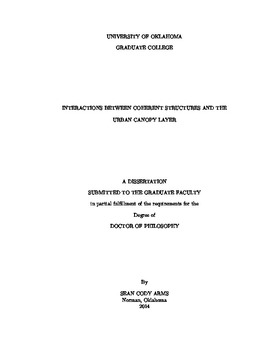| dc.contributor.advisor | Klein, Petra | |
| dc.contributor.author | Arms, Sean | |
| dc.date.accessioned | 2014-12-11T20:48:18Z | |
| dc.date.available | 2014-12-11T20:48:18Z | |
| dc.date.issued | 2014-12-12 | |
| dc.identifier.uri | https://hdl.handle.net/11244/13872 | |
| dc.description.abstract | The focus of this dissertation research is to gain further insight into the interaction of coherent structures and the urban canopy layer (CS-UCL interactions). There is a growing body of evidence that suggests that periods of strong turbulence transport across the urban canopy layer are associated with larger scale coherent structures, particularly low speed streaks or low momentum regions.
A framework for the analysis of CS-UCL interactions at full-scale is constructed through the interrogation of Direct Numerical Simulation output. A classification scheme based on a new parameter, the low momentum region index (LMRi), is developed which can identify three types of periods of interaction in the DNS output: CS-UCL interaction, transitional, and non-interaction periods. Based on this CS-UCL interaction classification scheme, depictions of flow behavior and turbulence characteristics are created for the three interaction period types using conditional analysis. These conditional views improve upon the most advanced conceptual model of CS-UCL interactions by including the flow inside the canyon. These conditional views also offer a chance to study how CS-UCL interactions might manifest in full-scale datasets, which leads to a set of characteristic markers of the CS-UCL interaction from the point of view of a stationary observation point.
The most commonly used full-scale techniques for analyzing the impact of coherent structures, the quadrant analysis and wavelet analysis methods, are tested using simulated time series data from the DNS output. It is found that with some modifications, these techniques can be used to detect when low momentum region driven CS-UCL interactions occur within the modeled environment. The modified techniques are then applied to a dataset collected at the Cross Center, located on the campus of the University of Oklahoma. Conditional profiles are constructed to assess whether the characteristic markers found in the DNS output manifest at full-scale. It is found that both the modified quadrant analysis and modified wavelet analysis techniques pick up on the same phenomena, demonstrating that this is the case. It is suggested that these modified techniques be used in other urban canopy layer studies to see if the same characteristic profiles and flow patterns are present. | en_US |
| dc.language | en_US | en_US |
| dc.subject | Coherent Structures Turbulence | en_US |
| dc.title | Interactions Between Coherent Structures and the Urban Canopy Layer | en_US |
| dc.contributor.committeeMember | Chilson, Phillip | |
| dc.contributor.committeeMember | Fedorovich, Evgeni | |
| dc.contributor.committeeMember | Shapiro, Alan | |
| dc.contributor.committeeMember | Tarhule, Andover | |
| dc.date.manuscript | 2014-12-09 | |
| dc.thesis.degree | Ph.D. | en_US |
| ou.group | College of Atmospheric & Geographic Sciences::School of Meteorology | en_US |
| shareok.orcid | 0000-0001-9835-113X | en_US |
